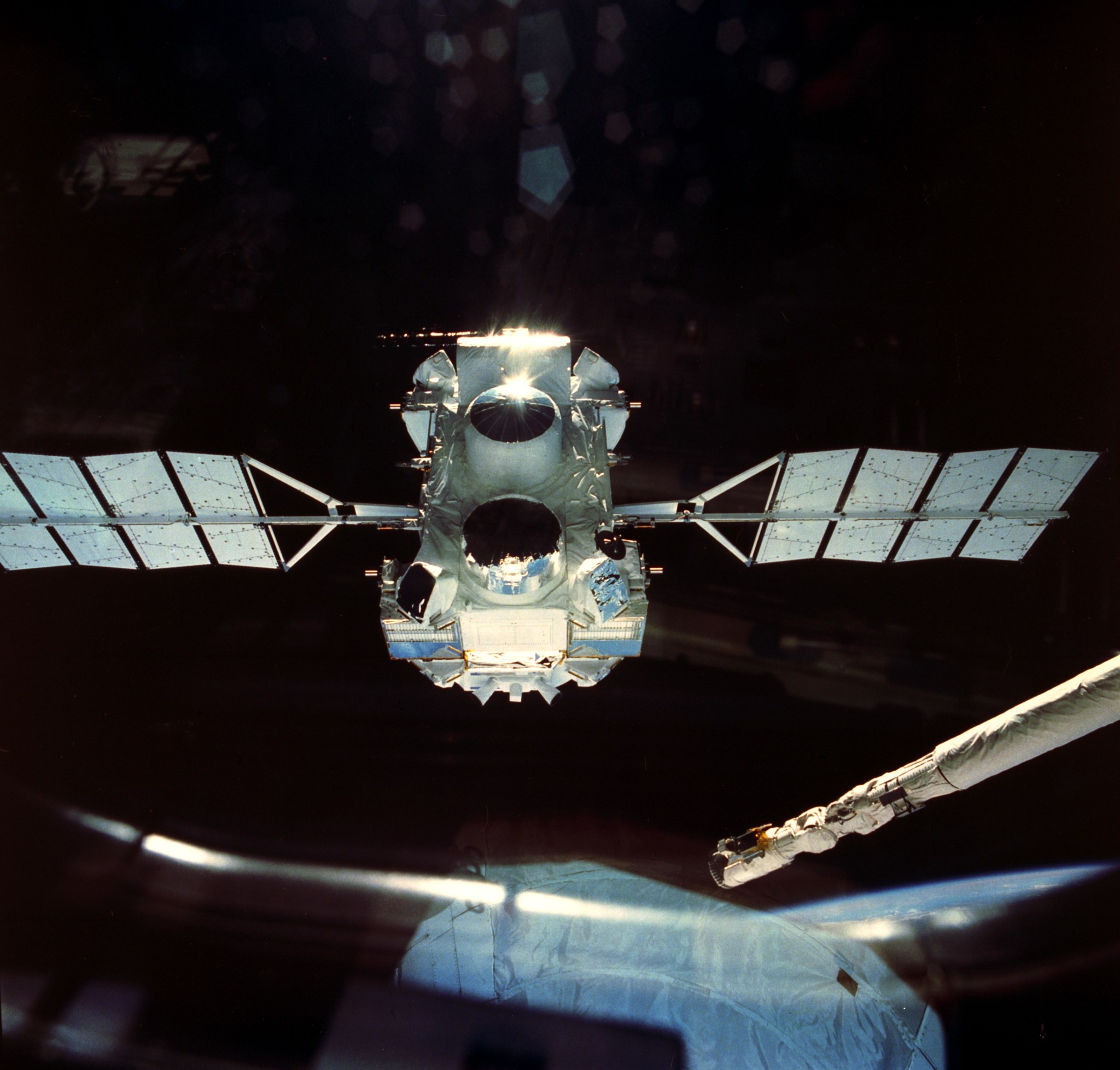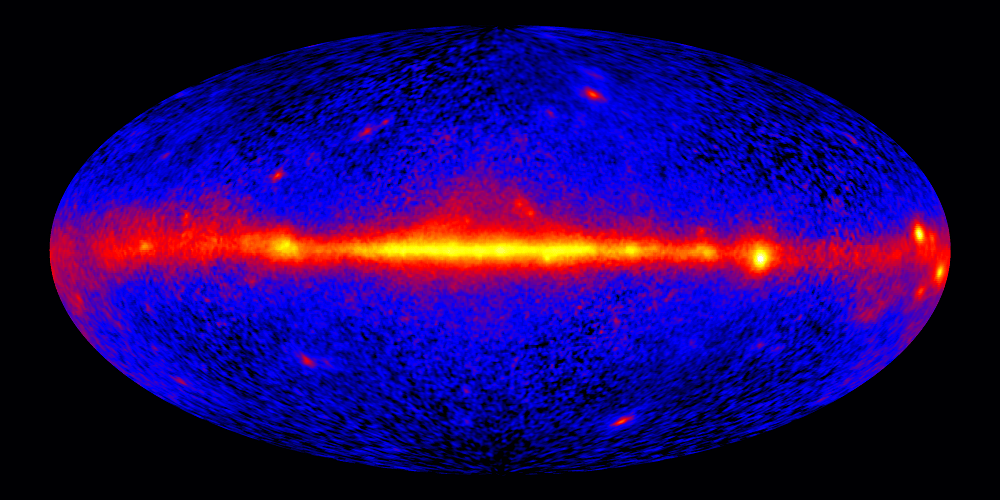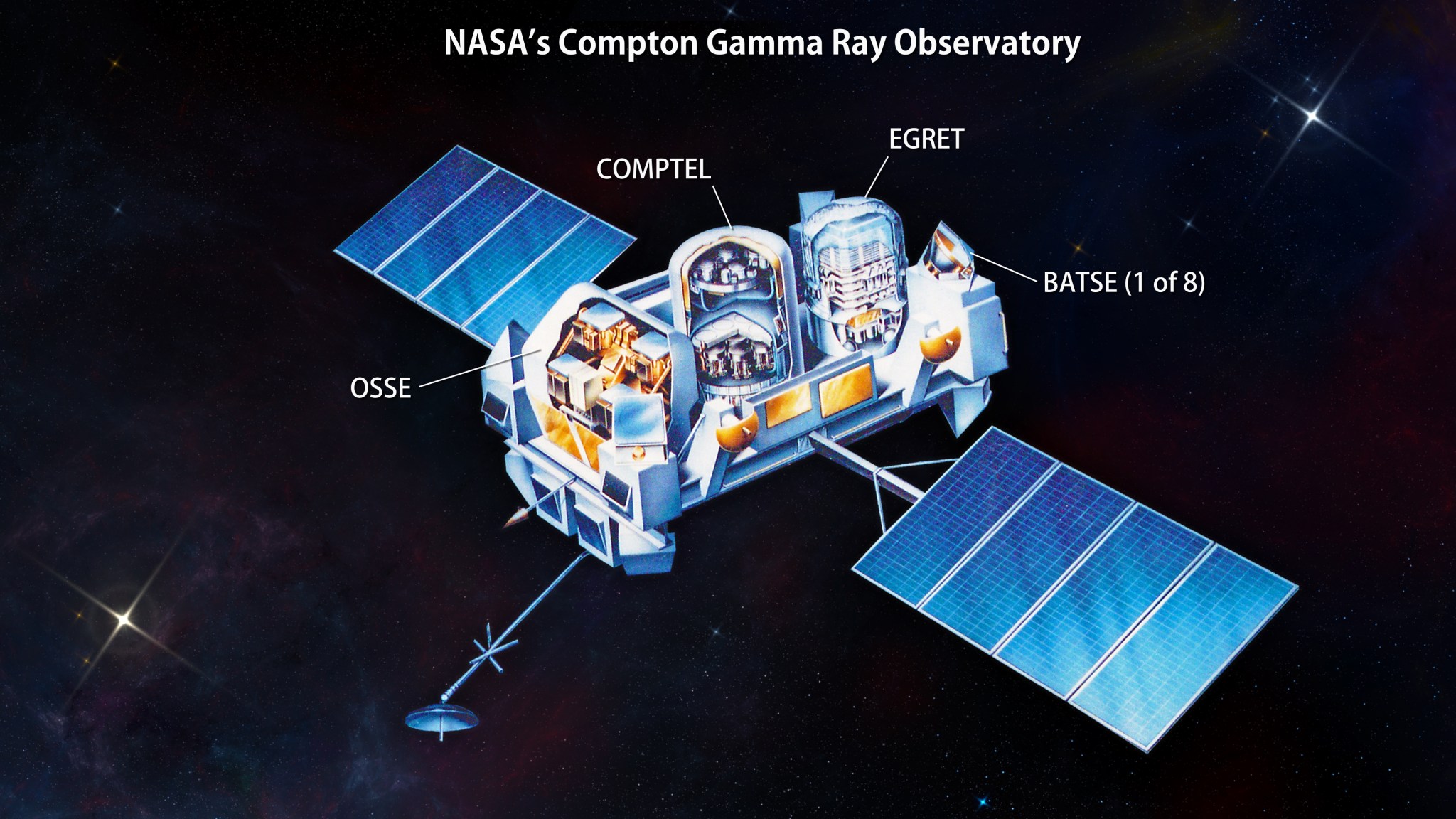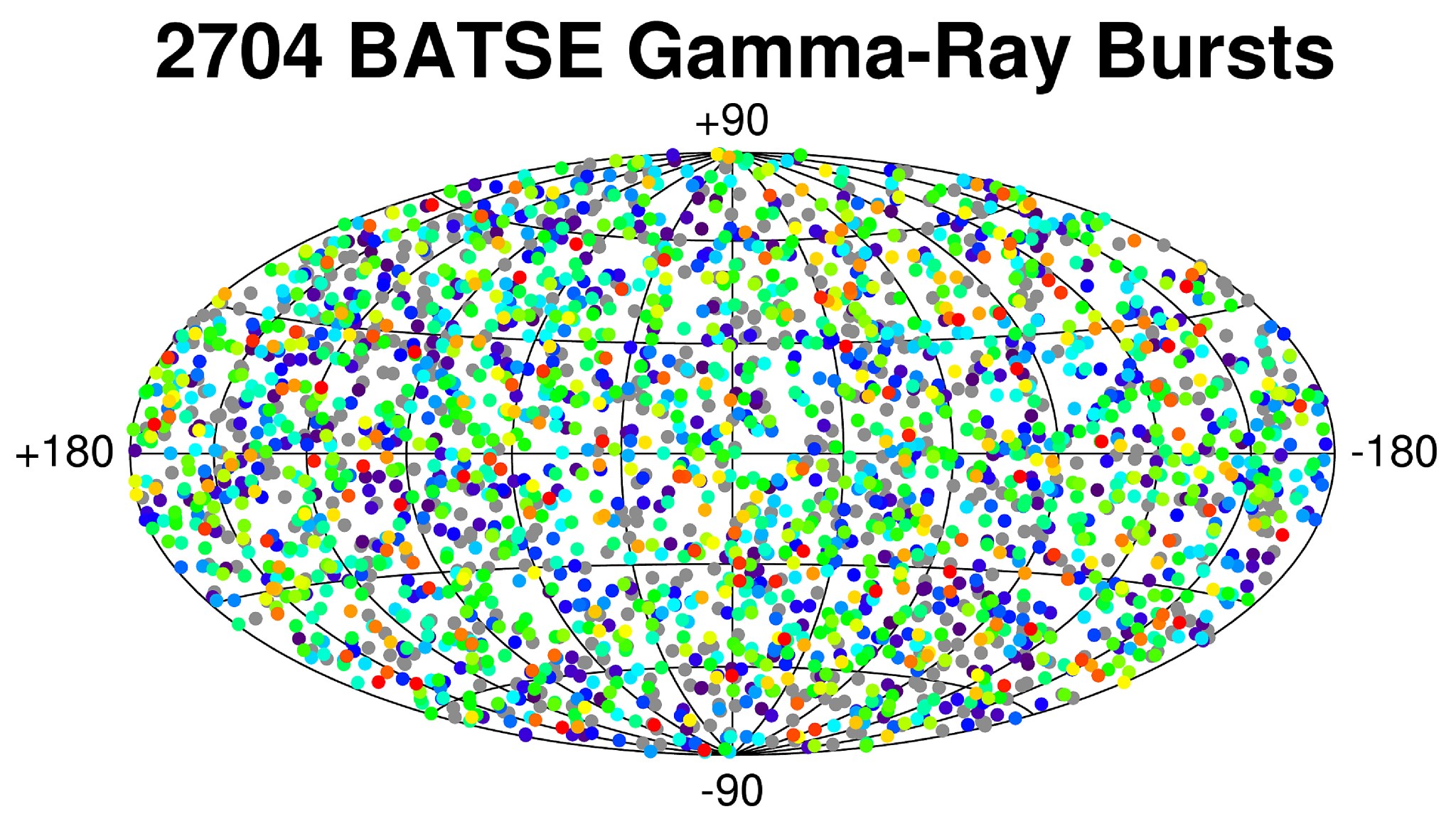Twenty-five years ago this week, NASA launched the Compton Gamma Ray Observatory, an astronomical satellite that transformed our knowledge of the high-energy sky. Over its nine-year lifetime, Compton produced the first-ever all-sky survey in gamma rays, the most energetic and penetrating form of light, discovered hundreds of new sources and unveiled a universe that was unexpectedly dynamic and diverse.

“The instruments were really a great leap forward, and they showed us for the first time just how varied and interesting the gamma-ray sky really is,” said Neil Gehrels, the mission’s project scientist, at NASA’s Goddard Space Flight Center in Greenbelt, Maryland.
Compton’s many findings included the discovery of a new class of galaxies powered by supermassive black holes, the surprising detection of gamma rays from thunderstorms on Earth, and the most persuasive evidence to date that gamma-ray bursts (GRBs) were the most distant and powerful explosions in the cosmos.
“When scientists saw the early results, it wasn’t long before discussions turned to the need for a new mission with improved instruments so we could get a better look at these exciting phenomena,” said Goddard’s Julie McEnery, the project scientist for NASA’s Fermi Gamma-ray Space Telescope. “Fermi is essentially the direct descendant of Compton and even involves many of the same people, including Neil.”

Compton was launched April 5, 1991, on STS-37, the eighth flight of the space shuttle Atlantis. On board were Commander Steven R. Nagel, Pilot Kenneth D. Cameron, and Mission Specialists Linda M. Godwin, Jerry L. Ross, and Jay Apt. At the time, the 17-ton observatory was the heaviest astrophysical payload ever flown, a record not broken until the launch of NASA’s Chandra X-ray Observatory and its propulsion stage in 1999.

On April 7, the crew prepared Compton for its release into orbit. Godwin guided the observatory out of the payload bay using the shuttle’s robot arm so the solar panels had room to unfurl. “We were elated when we saw the solar panels deploy properly, since those had been problematic on the ground,” said Apt, now a professor at Carnegie Mellon University’s Tepper School of Business and College of Engineering in Pittsburgh.
Then came the bad news. Ground controllers couldn’t unfold the high-gain antenna needed to send science data back to Earth. Efforts to free the structure included varying its temperature by rotating the shuttle’s payload bay in and out of sunlight and gently wiggling the shuttle arm, but it wouldn’t budge. With no options left, Ross and Apt were cleared for an unscheduled spacewalk, NASA’s first in nearly six years.
The astronauts saw no apparent reason for the failure, and Ross, who retired from NASA in 2012 as the first person launched into space seven times, received approval to apply what he has called “a good old farm boy whack.” Supporting himself on Compton with his right hand, he reached out with his left and shoved the boom twice with about 40 pounds of force. Nothing happened. “I pushed a third and fourth time and it started to move a little. Finally, on the fifth and six tries, the boom swung free,” he recalled. With that, the spacewalkers proceeded to the opposite end of the boom, manually swung the antenna to its full extent and locked it into place, clearing the way for Compton’s release.
Then known simply as the Gamma Ray Observatory, it was soon renamed in honor of Arthur Holly Compton, an American physicist and Nobel laureate who discovered that high-energy light underwent a change in wavelength when it scattered off electrons and other charged particles. This process played a central role in gamma-ray detection techniques used in all of the observatory’s instruments.

Cosmic gamma rays are few and far between — and the higher their energy, the rarer they become. Compton’s four gamma-ray instruments were the largest orbited to date and achieved better than 10 times the sensitivity of previous missions. In increasing order of their energy ranges, they were the Burst And Transient Source Experiment (BATSE), the Oriented Scintillation Spectrometer Experiment (OSSE), the Imaging Compton Telescope (COMPTEL), and the Energetic Gamma Ray Experiment Telescope (EGRET). Taken together, they covered an unprecedented energy range, from 20,000 electron volts (eV) to 30 billion electron volts (GeV). For comparison, visible light ranges from about 2 to 3 eV.
BATSE was developed at NASA’s Marshall Space Flight Center in Huntsville, Alabama, and provided the first compelling evidence that brief, intense, almost daily gamma-ray bursts resided far beyond our galaxy. “GRBs had bedeviled astronomers for several decades before Compton was launched, and the consensus among astronomers was that they came from neutron stars within our galaxy,” said Gerald Fishman, who led the experiment and is now a co-investigator on Fermi’s Gamma-ray Burst Monitor at the University of Alabama in Huntsville.
It was quickly evident GRBs were distributed all over the sky instead of in a pattern reflecting the structure of our Milky Way galaxy, strongly suggesting the bursts were originating far beyond our cosmic neighborhood. Proof of this came in 1997 when ground-based observatories were able to rapidly perform follow-up studies of GRBs seen by the Italian-Dutch satellite BeppoSAX. We now know these bursts are extraordinary explosions located millions to billions of light-years away, usually a result of the deaths of massive stars or mergers of neutron stars and black holes. Both Fermi and NASA’s Swift satellite continue to study GRBs, and each mission has detected more than a thousand to date.

The EGRET instrument on Compton, led by Goddard’s Carl Fichtel, was built in collaboration with Stanford University, the Max Planck Institute in Germany, and Grumman Aerospace. It conducted the first all-sky survey of high-energy gamma rays, which have energies above 100 million electron volts (MeV). A major finding was the discovery of a new class of active galaxies that produce most of their light at these energies.
An active galaxy is an otherwise typical galaxy with a compact and unusually bright core. The greater-than-normal luminosity of this central region is produced by matter falling toward a supermassive black hole weighing millions of times the mass of our sun. As it approaches the black hole, some of the material becomes channeled into particle jets moving outward in opposite directions at nearly the speed of light. In quasars and blazars, the most luminous active galaxy types, one of these jets happens to point almost directly at Earth. When viewing these sources, we’re effectively looking down the barrel of a black-hole-powered cosmic cannon. EGRET showed these jets reach much higher energies than previously suspected.
When Compton launched, high-energy gamma rays had been detected from only one galaxy other than our own, a quasar named 3C 273. Yet when EGRET imaged the area in June 1991, scientists saw another quasar, 3C 279, undergoing an outburst that made it one of the brightest objects in the gamma-ray sky. It became the archetypal gamma-ray blazar, and most of the discrete objects identified by EGRET, as well as those now being cataloged by Fermi, fall into this class. 3C 279 has since produced even larger flares.
Compton’s other instruments also produced impressive results. OSSE, led by James Kurfess of the Naval Research Laboratory in Washington, mapped gamma rays from a cloud of antimatter surrounding the central region of our galaxy. COMPTEL, a European-led instrument with principal investigator Volker Schoenfelder at the Max Plank Institute in Germany, identified locations in our galaxy where newly formed radioactive elements, such as aluminum-26, could be found.
Compton was the second of NASA’s Great Observatories, a series of ambitious astronomical satellites designed to explore different parts of the electromagnetic spectrum. The first mission in the program was the Hubble Space Telescope launched in 1990. Compton was followed by the Chandra X-ray Observatory in 1999 and the infrared-sensitive Spitzer Space Telescope in 2003. All of them remain operational today except Compton, which was deliberately deorbited in 2000 following the failure of one of its gyroscopes. Its scientific legacy continues in Fermi, Swift and other space observatories exploring the universe’s highest-energy light and the extreme phenomena producing it.
Download additional high-resolution images at NASA’s Scientific Visualization Studio
By Francis Reddy
NASA’s Goddard Space Flight Center, Greenbelt, Maryland

























